Family Nursing: Patient Selection and Health Promotion Strategies
VerifiedAdded on 2022/08/12
|10
|2177
|31
Report
AI Summary
This report delves into the principles of family nursing, focusing on a nurse's decision-making process in selecting patients from a given list of bios. The author, reflecting on their values and beliefs, chose three patients—Alex Abraham (Type II diabetes), Bernetta Bold (isolated after spouse's death), and Ernie Erbach (polysubstance abuse)—justifying the selection based on the impact of family dynamics on health outcomes. The report details the family nursing assessment approaches, including the use of genograms and ecomaps, and outlines health promotion strategies tailored to each patient's needs, such as education and counseling. Conversely, the author explains why they excluded three other patients, outlining alternative assessment and promotion approaches for those scenarios. The report integrates family systems theory, family stress theory, and change theory to guide the assessment and promotion processes, emphasizing the role of family in health and well-being. The document concludes by summarizing the importance of family-centered care and the effective application of various nursing theories and models, like Roy's adaptation model and Nightingale's theory, to improve patient outcomes. The references support the analysis of the assignment.
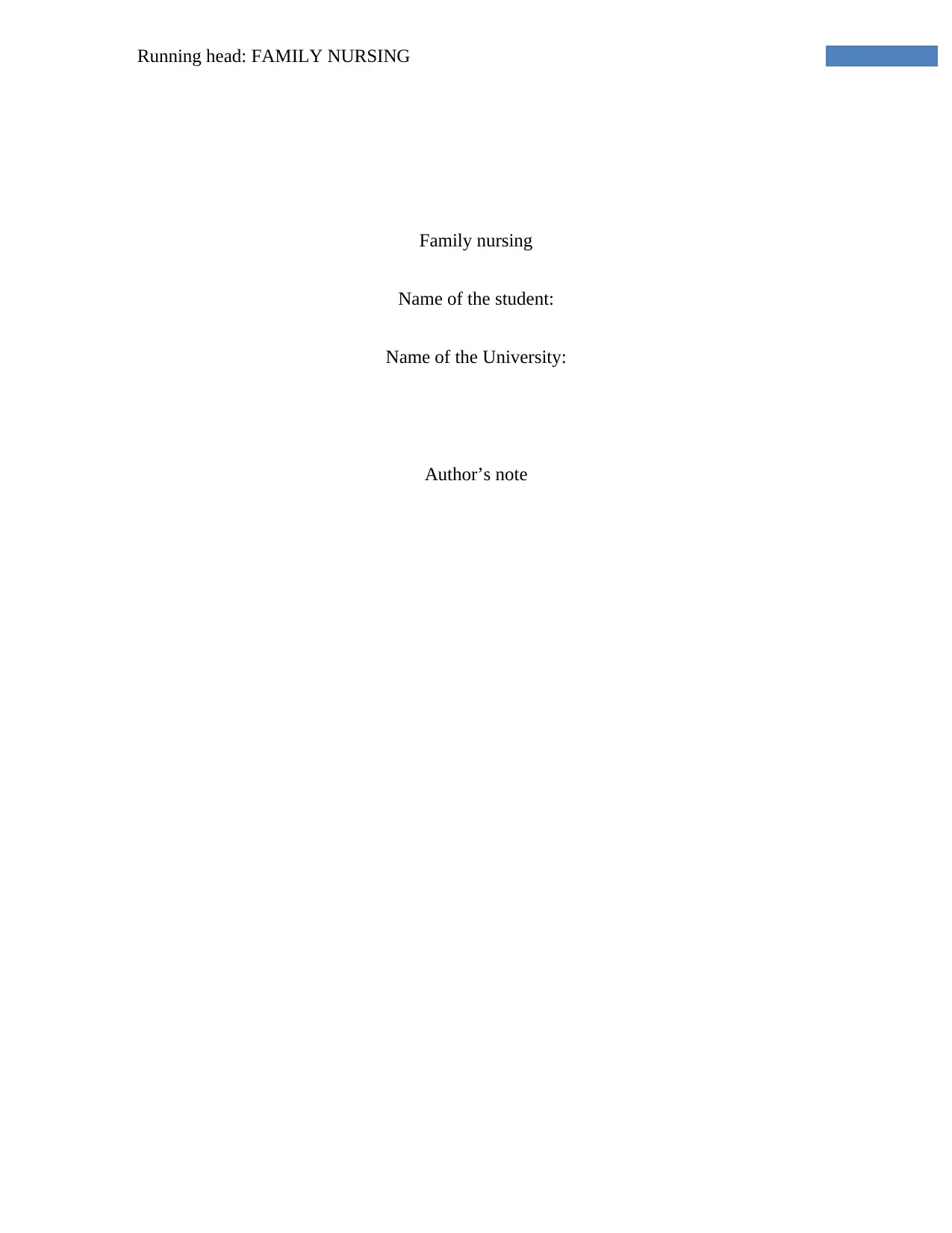
Running head: FAMILY NURSING
Family nursing
Name of the student:
Name of the University:
Author’s note
Family nursing
Name of the student:
Name of the University:
Author’s note
Paraphrase This Document
Need a fresh take? Get an instant paraphrase of this document with our AI Paraphraser
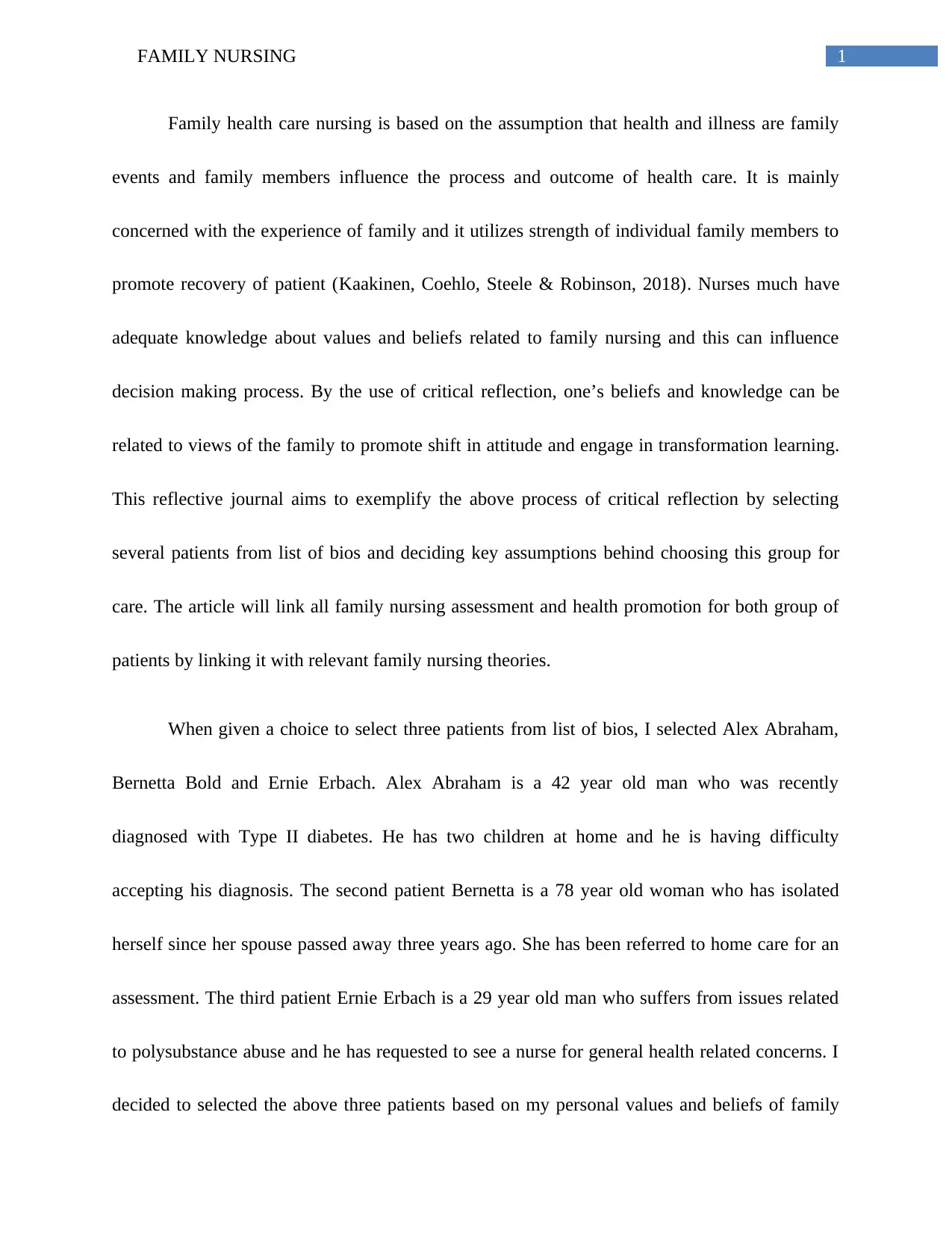
1FAMILY NURSING
Family health care nursing is based on the assumption that health and illness are family
events and family members influence the process and outcome of health care. It is mainly
concerned with the experience of family and it utilizes strength of individual family members to
promote recovery of patient (Kaakinen, Coehlo, Steele & Robinson, 2018). Nurses much have
adequate knowledge about values and beliefs related to family nursing and this can influence
decision making process. By the use of critical reflection, one’s beliefs and knowledge can be
related to views of the family to promote shift in attitude and engage in transformation learning.
This reflective journal aims to exemplify the above process of critical reflection by selecting
several patients from list of bios and deciding key assumptions behind choosing this group for
care. The article will link all family nursing assessment and health promotion for both group of
patients by linking it with relevant family nursing theories.
When given a choice to select three patients from list of bios, I selected Alex Abraham,
Bernetta Bold and Ernie Erbach. Alex Abraham is a 42 year old man who was recently
diagnosed with Type II diabetes. He has two children at home and he is having difficulty
accepting his diagnosis. The second patient Bernetta is a 78 year old woman who has isolated
herself since her spouse passed away three years ago. She has been referred to home care for an
assessment. The third patient Ernie Erbach is a 29 year old man who suffers from issues related
to polysubstance abuse and he has requested to see a nurse for general health related concerns. I
decided to selected the above three patients based on my personal values and beliefs of family
Family health care nursing is based on the assumption that health and illness are family
events and family members influence the process and outcome of health care. It is mainly
concerned with the experience of family and it utilizes strength of individual family members to
promote recovery of patient (Kaakinen, Coehlo, Steele & Robinson, 2018). Nurses much have
adequate knowledge about values and beliefs related to family nursing and this can influence
decision making process. By the use of critical reflection, one’s beliefs and knowledge can be
related to views of the family to promote shift in attitude and engage in transformation learning.
This reflective journal aims to exemplify the above process of critical reflection by selecting
several patients from list of bios and deciding key assumptions behind choosing this group for
care. The article will link all family nursing assessment and health promotion for both group of
patients by linking it with relevant family nursing theories.
When given a choice to select three patients from list of bios, I selected Alex Abraham,
Bernetta Bold and Ernie Erbach. Alex Abraham is a 42 year old man who was recently
diagnosed with Type II diabetes. He has two children at home and he is having difficulty
accepting his diagnosis. The second patient Bernetta is a 78 year old woman who has isolated
herself since her spouse passed away three years ago. She has been referred to home care for an
assessment. The third patient Ernie Erbach is a 29 year old man who suffers from issues related
to polysubstance abuse and he has requested to see a nurse for general health related concerns. I
decided to selected the above three patients based on my personal values and beliefs of family
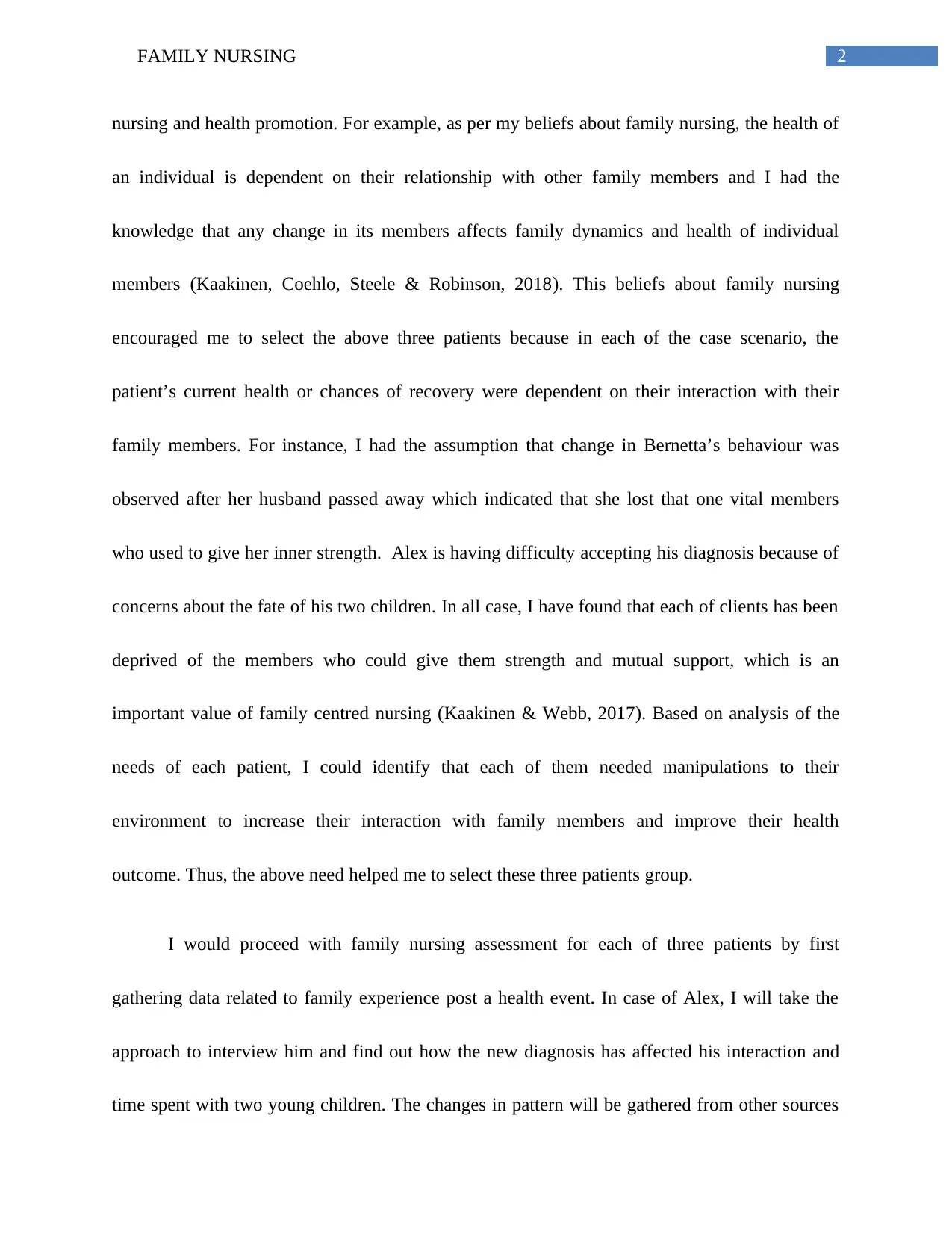
2FAMILY NURSING
nursing and health promotion. For example, as per my beliefs about family nursing, the health of
an individual is dependent on their relationship with other family members and I had the
knowledge that any change in its members affects family dynamics and health of individual
members (Kaakinen, Coehlo, Steele & Robinson, 2018). This beliefs about family nursing
encouraged me to select the above three patients because in each of the case scenario, the
patient’s current health or chances of recovery were dependent on their interaction with their
family members. For instance, I had the assumption that change in Bernetta’s behaviour was
observed after her husband passed away which indicated that she lost that one vital members
who used to give her inner strength. Alex is having difficulty accepting his diagnosis because of
concerns about the fate of his two children. In all case, I have found that each of clients has been
deprived of the members who could give them strength and mutual support, which is an
important value of family centred nursing (Kaakinen & Webb, 2017). Based on analysis of the
needs of each patient, I could identify that each of them needed manipulations to their
environment to increase their interaction with family members and improve their health
outcome. Thus, the above need helped me to select these three patients group.
I would proceed with family nursing assessment for each of three patients by first
gathering data related to family experience post a health event. In case of Alex, I will take the
approach to interview him and find out how the new diagnosis has affected his interaction and
time spent with two young children. The changes in pattern will be gathered from other sources
nursing and health promotion. For example, as per my beliefs about family nursing, the health of
an individual is dependent on their relationship with other family members and I had the
knowledge that any change in its members affects family dynamics and health of individual
members (Kaakinen, Coehlo, Steele & Robinson, 2018). This beliefs about family nursing
encouraged me to select the above three patients because in each of the case scenario, the
patient’s current health or chances of recovery were dependent on their interaction with their
family members. For instance, I had the assumption that change in Bernetta’s behaviour was
observed after her husband passed away which indicated that she lost that one vital members
who used to give her inner strength. Alex is having difficulty accepting his diagnosis because of
concerns about the fate of his two children. In all case, I have found that each of clients has been
deprived of the members who could give them strength and mutual support, which is an
important value of family centred nursing (Kaakinen & Webb, 2017). Based on analysis of the
needs of each patient, I could identify that each of them needed manipulations to their
environment to increase their interaction with family members and improve their health
outcome. Thus, the above need helped me to select these three patients group.
I would proceed with family nursing assessment for each of three patients by first
gathering data related to family experience post a health event. In case of Alex, I will take the
approach to interview him and find out how the new diagnosis has affected his interaction and
time spent with two young children. The changes in pattern will be gathered from other sources
⊘ This is a preview!⊘
Do you want full access?
Subscribe today to unlock all pages.

Trusted by 1+ million students worldwide
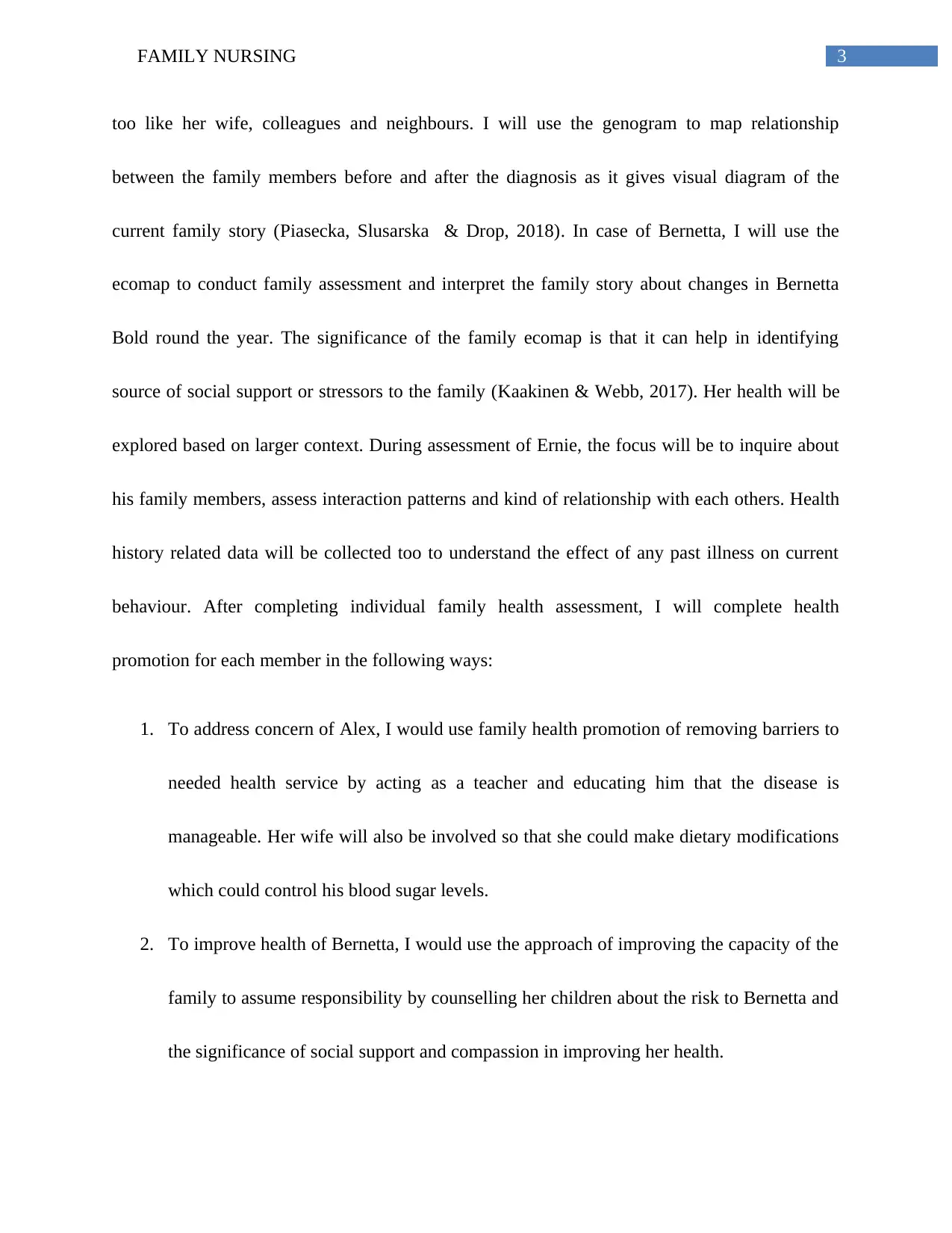
3FAMILY NURSING
too like her wife, colleagues and neighbours. I will use the genogram to map relationship
between the family members before and after the diagnosis as it gives visual diagram of the
current family story (Piasecka, Slusarska & Drop, 2018). In case of Bernetta, I will use the
ecomap to conduct family assessment and interpret the family story about changes in Bernetta
Bold round the year. The significance of the family ecomap is that it can help in identifying
source of social support or stressors to the family (Kaakinen & Webb, 2017). Her health will be
explored based on larger context. During assessment of Ernie, the focus will be to inquire about
his family members, assess interaction patterns and kind of relationship with each others. Health
history related data will be collected too to understand the effect of any past illness on current
behaviour. After completing individual family health assessment, I will complete health
promotion for each member in the following ways:
1. To address concern of Alex, I would use family health promotion of removing barriers to
needed health service by acting as a teacher and educating him that the disease is
manageable. Her wife will also be involved so that she could make dietary modifications
which could control his blood sugar levels.
2. To improve health of Bernetta, I would use the approach of improving the capacity of the
family to assume responsibility by counselling her children about the risk to Bernetta and
the significance of social support and compassion in improving her health.
too like her wife, colleagues and neighbours. I will use the genogram to map relationship
between the family members before and after the diagnosis as it gives visual diagram of the
current family story (Piasecka, Slusarska & Drop, 2018). In case of Bernetta, I will use the
ecomap to conduct family assessment and interpret the family story about changes in Bernetta
Bold round the year. The significance of the family ecomap is that it can help in identifying
source of social support or stressors to the family (Kaakinen & Webb, 2017). Her health will be
explored based on larger context. During assessment of Ernie, the focus will be to inquire about
his family members, assess interaction patterns and kind of relationship with each others. Health
history related data will be collected too to understand the effect of any past illness on current
behaviour. After completing individual family health assessment, I will complete health
promotion for each member in the following ways:
1. To address concern of Alex, I would use family health promotion of removing barriers to
needed health service by acting as a teacher and educating him that the disease is
manageable. Her wife will also be involved so that she could make dietary modifications
which could control his blood sugar levels.
2. To improve health of Bernetta, I would use the approach of improving the capacity of the
family to assume responsibility by counselling her children about the risk to Bernetta and
the significance of social support and compassion in improving her health.
Paraphrase This Document
Need a fresh take? Get an instant paraphrase of this document with our AI Paraphraser
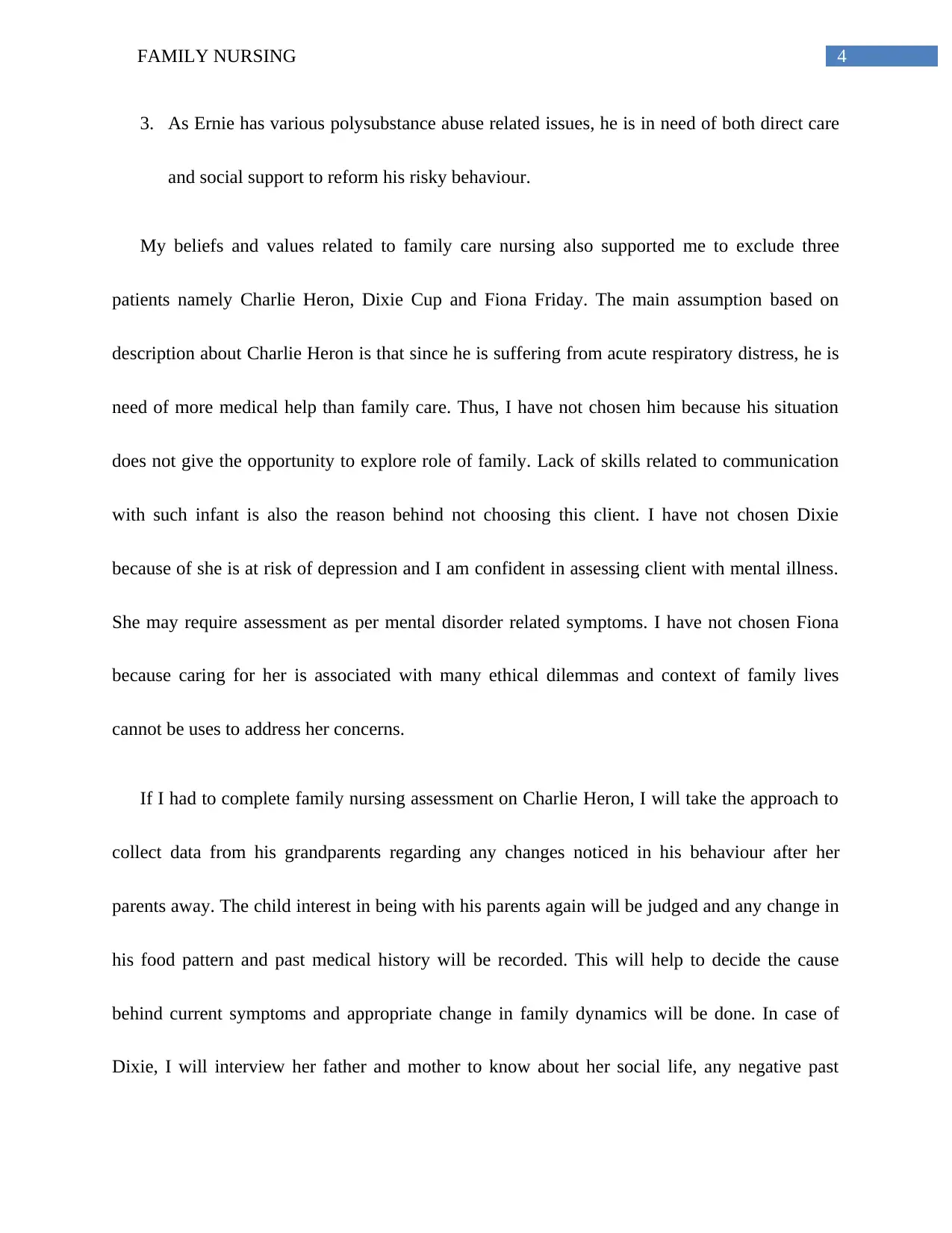
4FAMILY NURSING
3. As Ernie has various polysubstance abuse related issues, he is in need of both direct care
and social support to reform his risky behaviour.
My beliefs and values related to family care nursing also supported me to exclude three
patients namely Charlie Heron, Dixie Cup and Fiona Friday. The main assumption based on
description about Charlie Heron is that since he is suffering from acute respiratory distress, he is
need of more medical help than family care. Thus, I have not chosen him because his situation
does not give the opportunity to explore role of family. Lack of skills related to communication
with such infant is also the reason behind not choosing this client. I have not chosen Dixie
because of she is at risk of depression and I am confident in assessing client with mental illness.
She may require assessment as per mental disorder related symptoms. I have not chosen Fiona
because caring for her is associated with many ethical dilemmas and context of family lives
cannot be uses to address her concerns.
If I had to complete family nursing assessment on Charlie Heron, I will take the approach to
collect data from his grandparents regarding any changes noticed in his behaviour after her
parents away. The child interest in being with his parents again will be judged and any change in
his food pattern and past medical history will be recorded. This will help to decide the cause
behind current symptoms and appropriate change in family dynamics will be done. In case of
Dixie, I will interview her father and mother to know about her social life, any negative past
3. As Ernie has various polysubstance abuse related issues, he is in need of both direct care
and social support to reform his risky behaviour.
My beliefs and values related to family care nursing also supported me to exclude three
patients namely Charlie Heron, Dixie Cup and Fiona Friday. The main assumption based on
description about Charlie Heron is that since he is suffering from acute respiratory distress, he is
need of more medical help than family care. Thus, I have not chosen him because his situation
does not give the opportunity to explore role of family. Lack of skills related to communication
with such infant is also the reason behind not choosing this client. I have not chosen Dixie
because of she is at risk of depression and I am confident in assessing client with mental illness.
She may require assessment as per mental disorder related symptoms. I have not chosen Fiona
because caring for her is associated with many ethical dilemmas and context of family lives
cannot be uses to address her concerns.
If I had to complete family nursing assessment on Charlie Heron, I will take the approach to
collect data from his grandparents regarding any changes noticed in his behaviour after her
parents away. The child interest in being with his parents again will be judged and any change in
his food pattern and past medical history will be recorded. This will help to decide the cause
behind current symptoms and appropriate change in family dynamics will be done. In case of
Dixie, I will interview her father and mother to know about her social life, any negative past
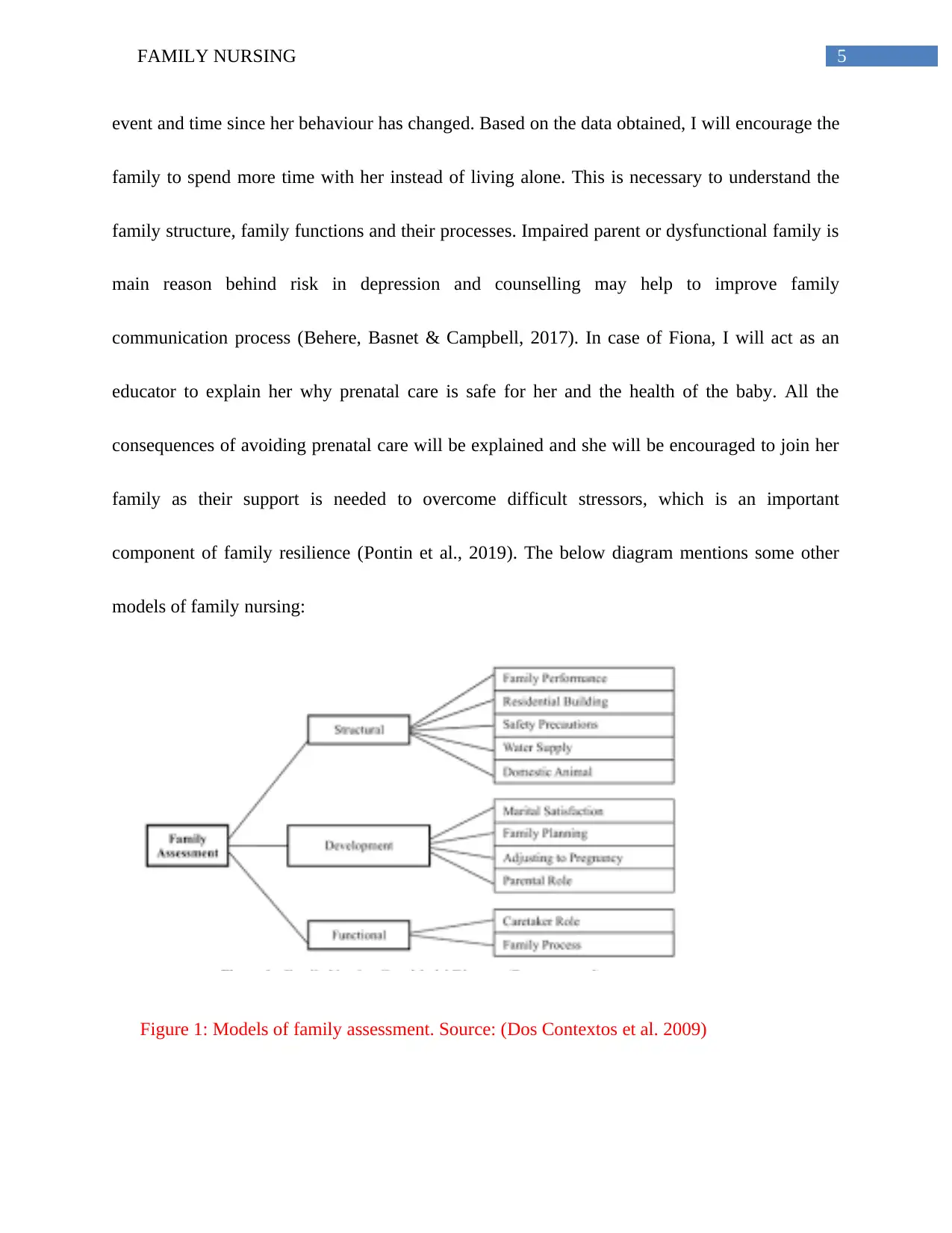
5FAMILY NURSING
event and time since her behaviour has changed. Based on the data obtained, I will encourage the
family to spend more time with her instead of living alone. This is necessary to understand the
family structure, family functions and their processes. Impaired parent or dysfunctional family is
main reason behind risk in depression and counselling may help to improve family
communication process (Behere, Basnet & Campbell, 2017). In case of Fiona, I will act as an
educator to explain her why prenatal care is safe for her and the health of the baby. All the
consequences of avoiding prenatal care will be explained and she will be encouraged to join her
family as their support is needed to overcome difficult stressors, which is an important
component of family resilience (Pontin et al., 2019). The below diagram mentions some other
models of family nursing:
Figure 1: Models of family assessment. Source: (Dos Contextos et al. 2009)
event and time since her behaviour has changed. Based on the data obtained, I will encourage the
family to spend more time with her instead of living alone. This is necessary to understand the
family structure, family functions and their processes. Impaired parent or dysfunctional family is
main reason behind risk in depression and counselling may help to improve family
communication process (Behere, Basnet & Campbell, 2017). In case of Fiona, I will act as an
educator to explain her why prenatal care is safe for her and the health of the baby. All the
consequences of avoiding prenatal care will be explained and she will be encouraged to join her
family as their support is needed to overcome difficult stressors, which is an important
component of family resilience (Pontin et al., 2019). The below diagram mentions some other
models of family nursing:
Figure 1: Models of family assessment. Source: (Dos Contextos et al. 2009)
⊘ This is a preview!⊘
Do you want full access?
Subscribe today to unlock all pages.

Trusted by 1+ million students worldwide
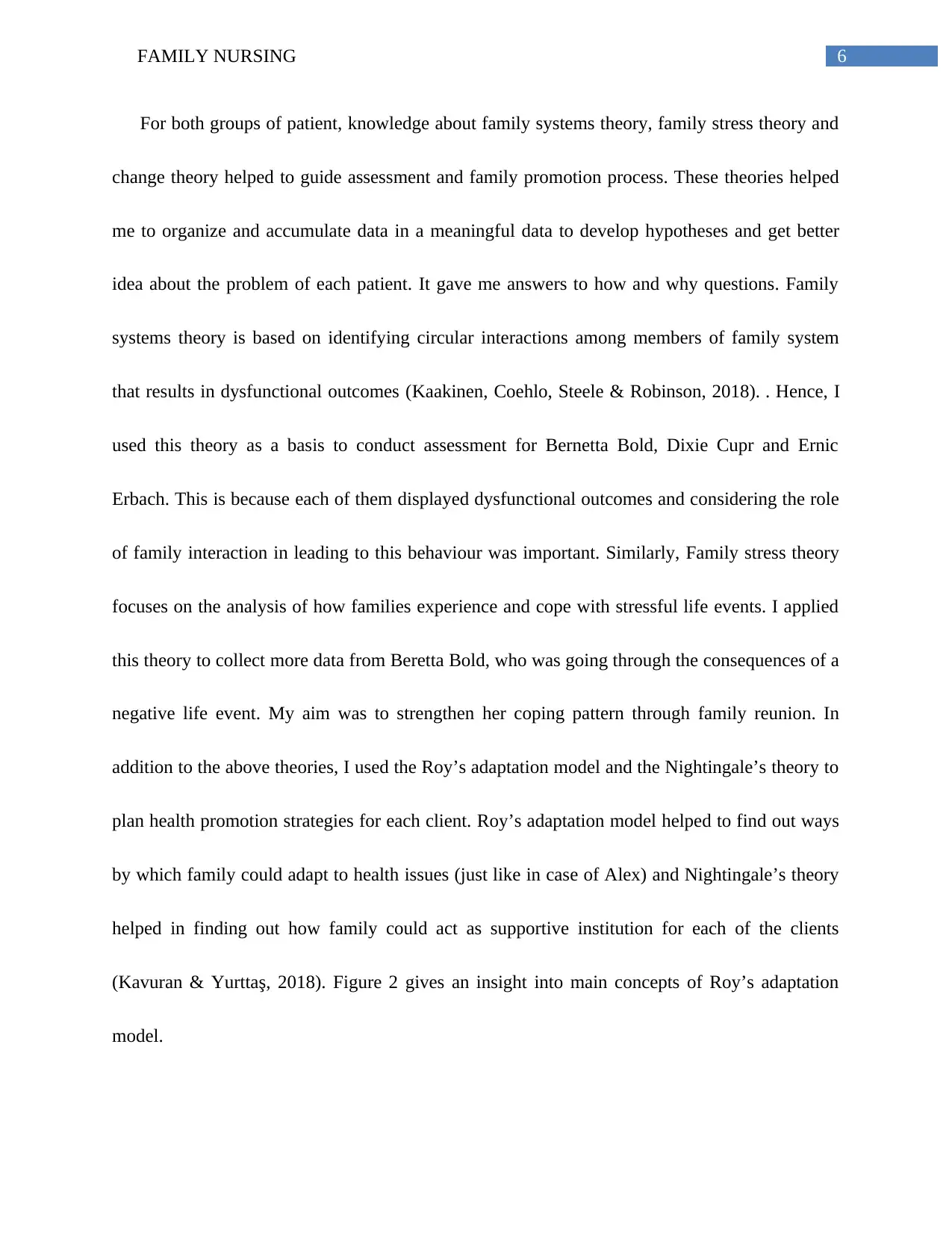
6FAMILY NURSING
For both groups of patient, knowledge about family systems theory, family stress theory and
change theory helped to guide assessment and family promotion process. These theories helped
me to organize and accumulate data in a meaningful data to develop hypotheses and get better
idea about the problem of each patient. It gave me answers to how and why questions. Family
systems theory is based on identifying circular interactions among members of family system
that results in dysfunctional outcomes (Kaakinen, Coehlo, Steele & Robinson, 2018). . Hence, I
used this theory as a basis to conduct assessment for Bernetta Bold, Dixie Cupr and Ernic
Erbach. This is because each of them displayed dysfunctional outcomes and considering the role
of family interaction in leading to this behaviour was important. Similarly, Family stress theory
focuses on the analysis of how families experience and cope with stressful life events. I applied
this theory to collect more data from Beretta Bold, who was going through the consequences of a
negative life event. My aim was to strengthen her coping pattern through family reunion. In
addition to the above theories, I used the Roy’s adaptation model and the Nightingale’s theory to
plan health promotion strategies for each client. Roy’s adaptation model helped to find out ways
by which family could adapt to health issues (just like in case of Alex) and Nightingale’s theory
helped in finding out how family could act as supportive institution for each of the clients
(Kavuran & Yurttaş, 2018). Figure 2 gives an insight into main concepts of Roy’s adaptation
model.
For both groups of patient, knowledge about family systems theory, family stress theory and
change theory helped to guide assessment and family promotion process. These theories helped
me to organize and accumulate data in a meaningful data to develop hypotheses and get better
idea about the problem of each patient. It gave me answers to how and why questions. Family
systems theory is based on identifying circular interactions among members of family system
that results in dysfunctional outcomes (Kaakinen, Coehlo, Steele & Robinson, 2018). . Hence, I
used this theory as a basis to conduct assessment for Bernetta Bold, Dixie Cupr and Ernic
Erbach. This is because each of them displayed dysfunctional outcomes and considering the role
of family interaction in leading to this behaviour was important. Similarly, Family stress theory
focuses on the analysis of how families experience and cope with stressful life events. I applied
this theory to collect more data from Beretta Bold, who was going through the consequences of a
negative life event. My aim was to strengthen her coping pattern through family reunion. In
addition to the above theories, I used the Roy’s adaptation model and the Nightingale’s theory to
plan health promotion strategies for each client. Roy’s adaptation model helped to find out ways
by which family could adapt to health issues (just like in case of Alex) and Nightingale’s theory
helped in finding out how family could act as supportive institution for each of the clients
(Kavuran & Yurttaş, 2018). Figure 2 gives an insight into main concepts of Roy’s adaptation
model.
Paraphrase This Document
Need a fresh take? Get an instant paraphrase of this document with our AI Paraphraser
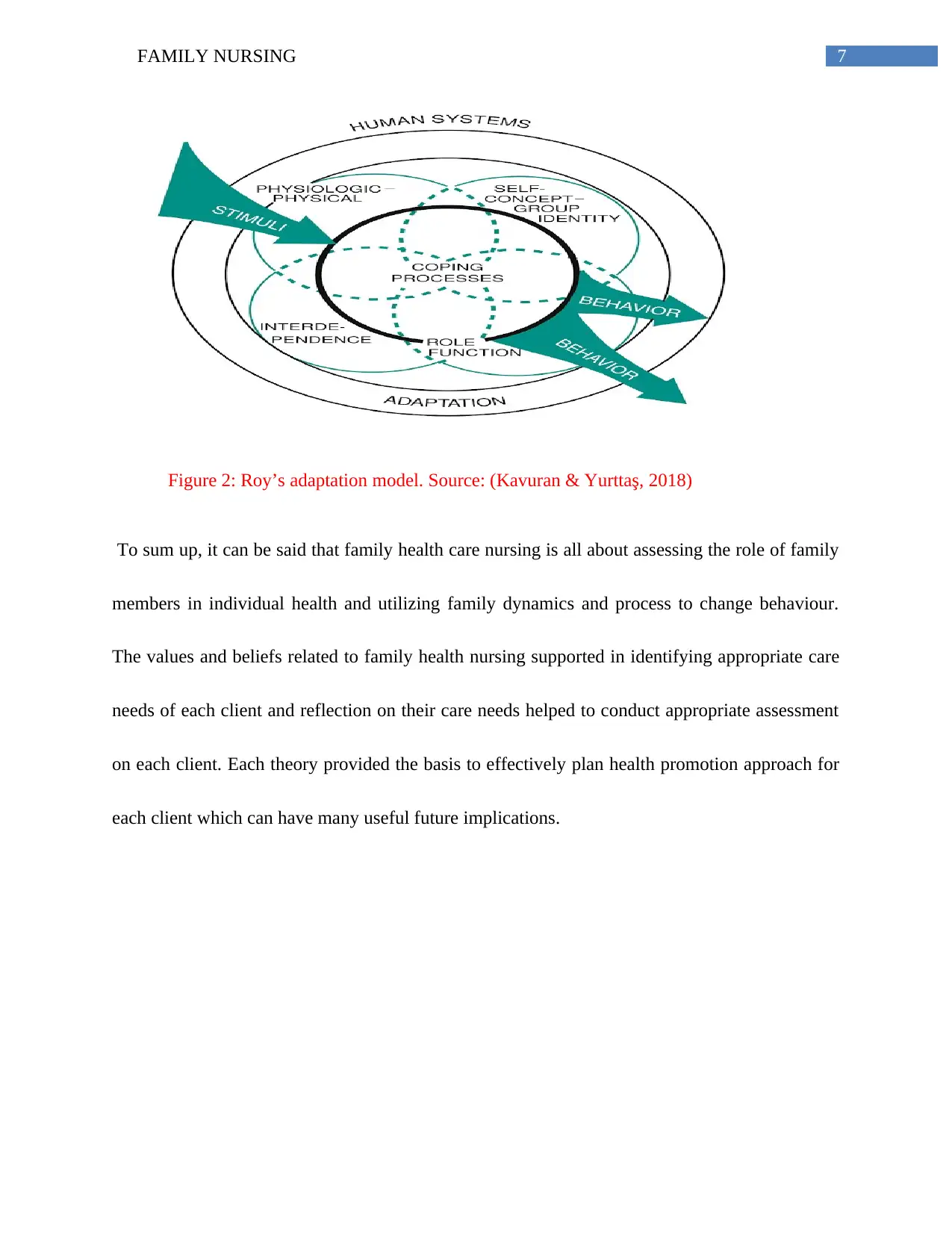
7FAMILY NURSING
Figure 2: Roy’s adaptation model. Source: (Kavuran & Yurttaş, 2018)
To sum up, it can be said that family health care nursing is all about assessing the role of family
members in individual health and utilizing family dynamics and process to change behaviour.
The values and beliefs related to family health nursing supported in identifying appropriate care
needs of each client and reflection on their care needs helped to conduct appropriate assessment
on each client. Each theory provided the basis to effectively plan health promotion approach for
each client which can have many useful future implications.
Figure 2: Roy’s adaptation model. Source: (Kavuran & Yurttaş, 2018)
To sum up, it can be said that family health care nursing is all about assessing the role of family
members in individual health and utilizing family dynamics and process to change behaviour.
The values and beliefs related to family health nursing supported in identifying appropriate care
needs of each client and reflection on their care needs helped to conduct appropriate assessment
on each client. Each theory provided the basis to effectively plan health promotion approach for
each client which can have many useful future implications.
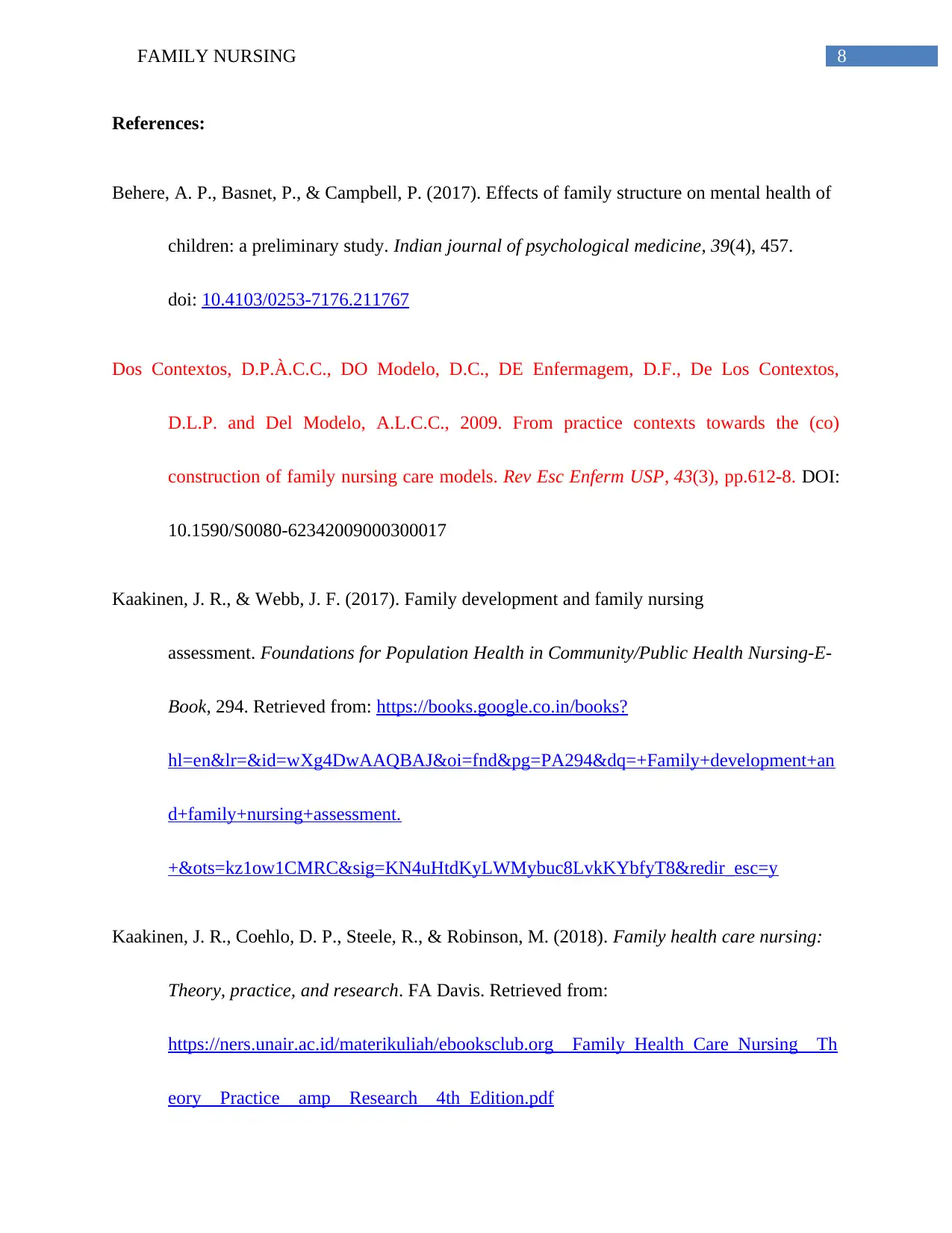
8FAMILY NURSING
References:
Behere, A. P., Basnet, P., & Campbell, P. (2017). Effects of family structure on mental health of
children: a preliminary study. Indian journal of psychological medicine, 39(4), 457.
doi: 10.4103/0253-7176.211767
Dos Contextos, D.P.À.C.C., DO Modelo, D.C., DE Enfermagem, D.F., De Los Contextos,
D.L.P. and Del Modelo, A.L.C.C., 2009. From practice contexts towards the (co)
construction of family nursing care models. Rev Esc Enferm USP, 43(3), pp.612-8. DOI:
10.1590/S0080-62342009000300017
Kaakinen, J. R., & Webb, J. F. (2017). Family development and family nursing
assessment. Foundations for Population Health in Community/Public Health Nursing-E-
Book, 294. Retrieved from: https://books.google.co.in/books?
hl=en&lr=&id=wXg4DwAAQBAJ&oi=fnd&pg=PA294&dq=+Family+development+an
d+family+nursing+assessment.
+&ots=kz1ow1CMRC&sig=KN4uHtdKyLWMybuc8LvkKYbfyT8&redir_esc=y
Kaakinen, J. R., Coehlo, D. P., Steele, R., & Robinson, M. (2018). Family health care nursing:
Theory, practice, and research. FA Davis. Retrieved from:
https://ners.unair.ac.id/materikuliah/ebooksclub.org__Family_Health_Care_Nursing__Th
eory__Practice__amp__Research__4th_Edition.pdf
References:
Behere, A. P., Basnet, P., & Campbell, P. (2017). Effects of family structure on mental health of
children: a preliminary study. Indian journal of psychological medicine, 39(4), 457.
doi: 10.4103/0253-7176.211767
Dos Contextos, D.P.À.C.C., DO Modelo, D.C., DE Enfermagem, D.F., De Los Contextos,
D.L.P. and Del Modelo, A.L.C.C., 2009. From practice contexts towards the (co)
construction of family nursing care models. Rev Esc Enferm USP, 43(3), pp.612-8. DOI:
10.1590/S0080-62342009000300017
Kaakinen, J. R., & Webb, J. F. (2017). Family development and family nursing
assessment. Foundations for Population Health in Community/Public Health Nursing-E-
Book, 294. Retrieved from: https://books.google.co.in/books?
hl=en&lr=&id=wXg4DwAAQBAJ&oi=fnd&pg=PA294&dq=+Family+development+an
d+family+nursing+assessment.
+&ots=kz1ow1CMRC&sig=KN4uHtdKyLWMybuc8LvkKYbfyT8&redir_esc=y
Kaakinen, J. R., Coehlo, D. P., Steele, R., & Robinson, M. (2018). Family health care nursing:
Theory, practice, and research. FA Davis. Retrieved from:
https://ners.unair.ac.id/materikuliah/ebooksclub.org__Family_Health_Care_Nursing__Th
eory__Practice__amp__Research__4th_Edition.pdf
⊘ This is a preview!⊘
Do you want full access?
Subscribe today to unlock all pages.

Trusted by 1+ million students worldwide
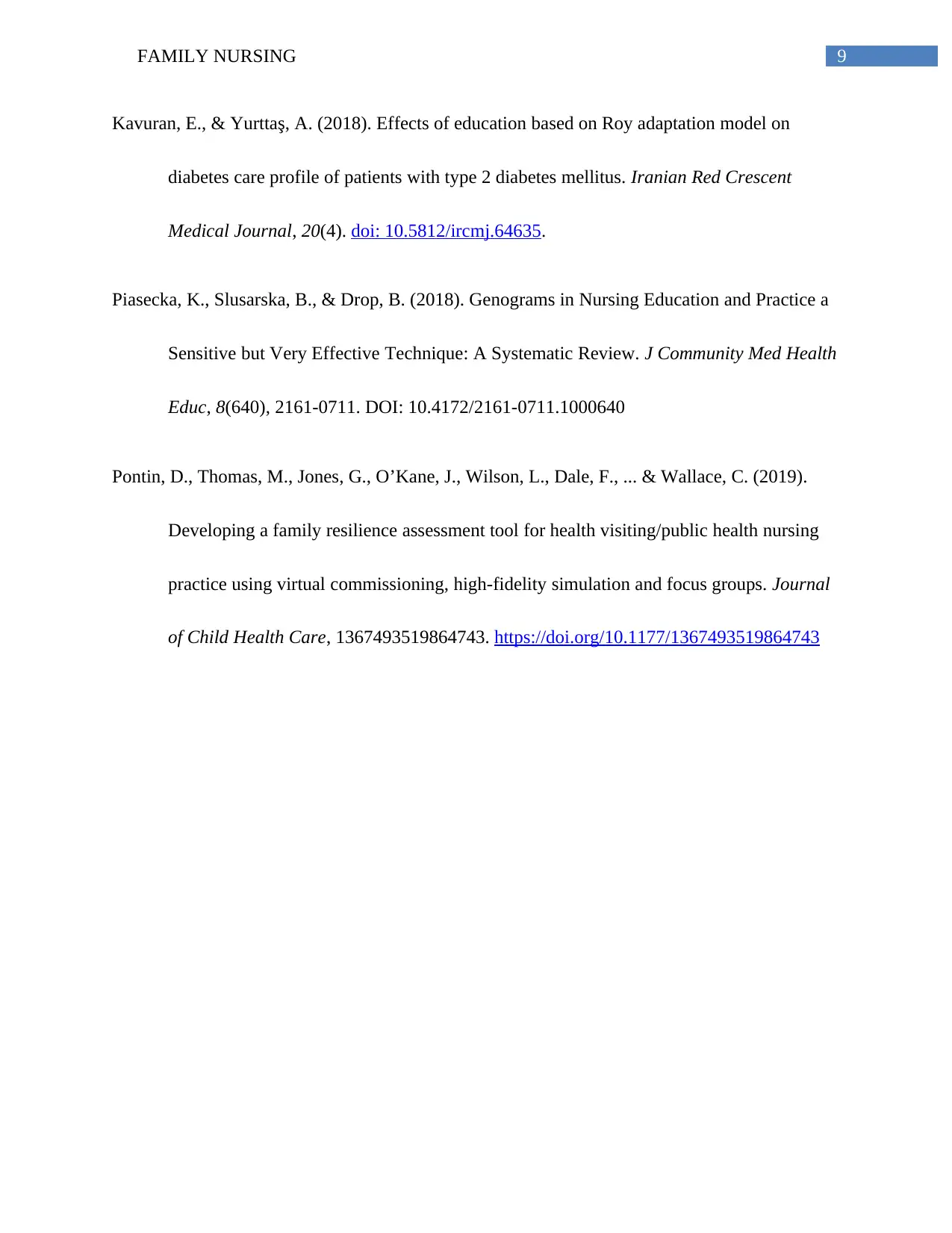
9FAMILY NURSING
Kavuran, E., & Yurttaş, A. (2018). Effects of education based on Roy adaptation model on
diabetes care profile of patients with type 2 diabetes mellitus. Iranian Red Crescent
Medical Journal, 20(4). doi: 10.5812/ircmj.64635.
Piasecka, K., Slusarska, B., & Drop, B. (2018). Genograms in Nursing Education and Practice a
Sensitive but Very Effective Technique: A Systematic Review. J Community Med Health
Educ, 8(640), 2161-0711. DOI: 10.4172/2161-0711.1000640
Pontin, D., Thomas, M., Jones, G., O’Kane, J., Wilson, L., Dale, F., ... & Wallace, C. (2019).
Developing a family resilience assessment tool for health visiting/public health nursing
practice using virtual commissioning, high-fidelity simulation and focus groups. Journal
of Child Health Care, 1367493519864743. https://doi.org/10.1177/1367493519864743
Kavuran, E., & Yurttaş, A. (2018). Effects of education based on Roy adaptation model on
diabetes care profile of patients with type 2 diabetes mellitus. Iranian Red Crescent
Medical Journal, 20(4). doi: 10.5812/ircmj.64635.
Piasecka, K., Slusarska, B., & Drop, B. (2018). Genograms in Nursing Education and Practice a
Sensitive but Very Effective Technique: A Systematic Review. J Community Med Health
Educ, 8(640), 2161-0711. DOI: 10.4172/2161-0711.1000640
Pontin, D., Thomas, M., Jones, G., O’Kane, J., Wilson, L., Dale, F., ... & Wallace, C. (2019).
Developing a family resilience assessment tool for health visiting/public health nursing
practice using virtual commissioning, high-fidelity simulation and focus groups. Journal
of Child Health Care, 1367493519864743. https://doi.org/10.1177/1367493519864743
1 out of 10
Related Documents
Your All-in-One AI-Powered Toolkit for Academic Success.
+13062052269
info@desklib.com
Available 24*7 on WhatsApp / Email
![[object Object]](/_next/static/media/star-bottom.7253800d.svg)
Unlock your academic potential
Copyright © 2020–2025 A2Z Services. All Rights Reserved. Developed and managed by ZUCOL.





